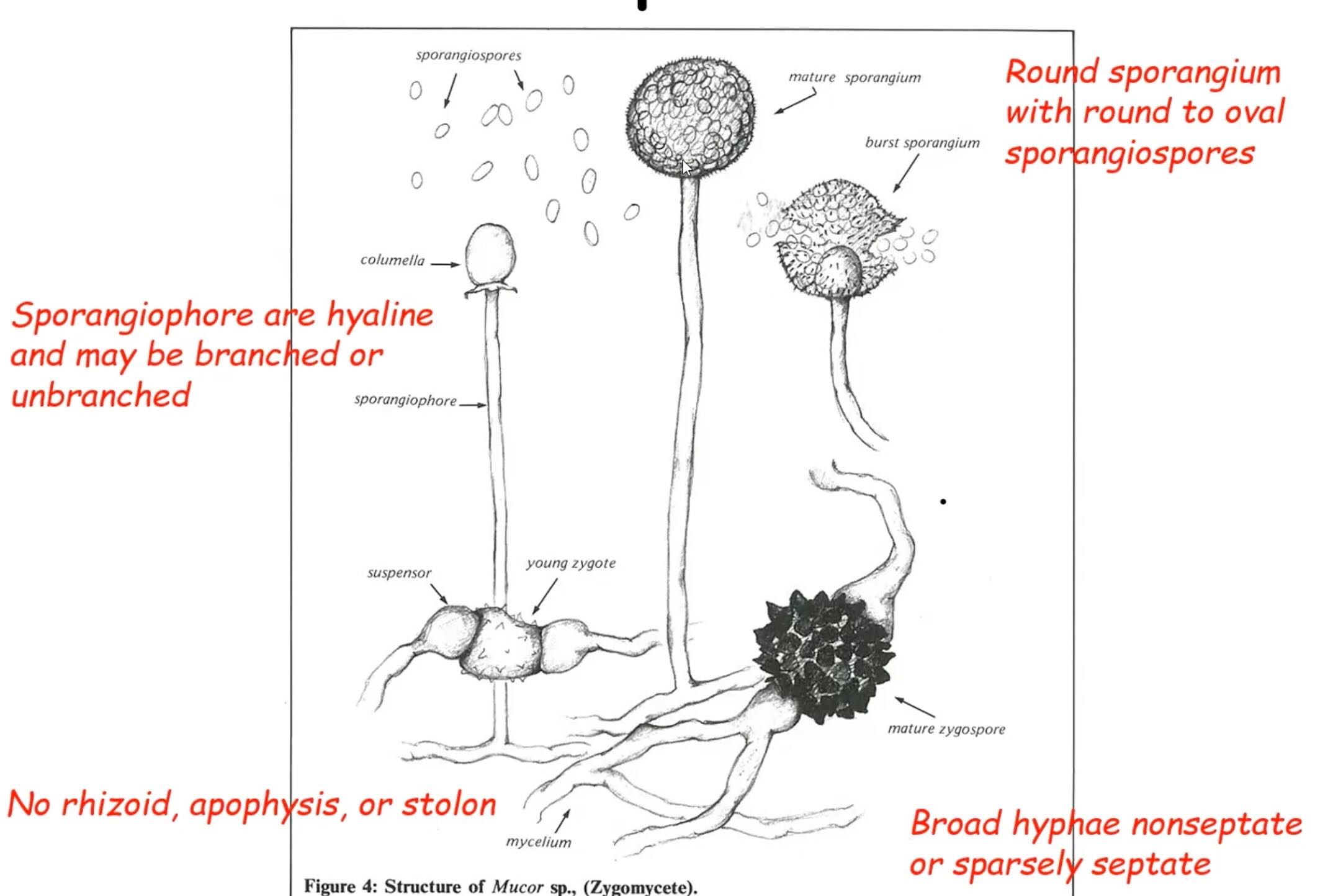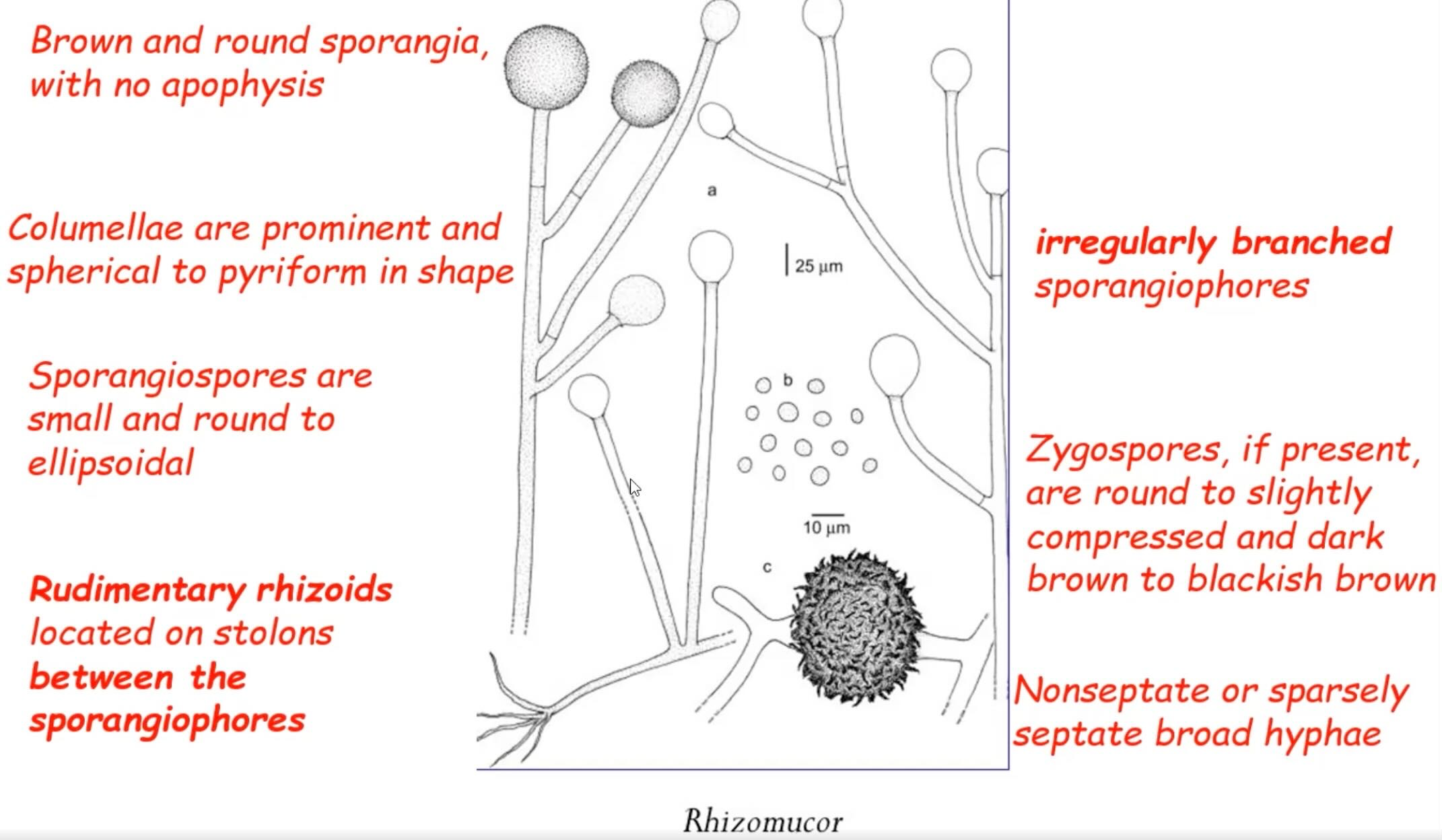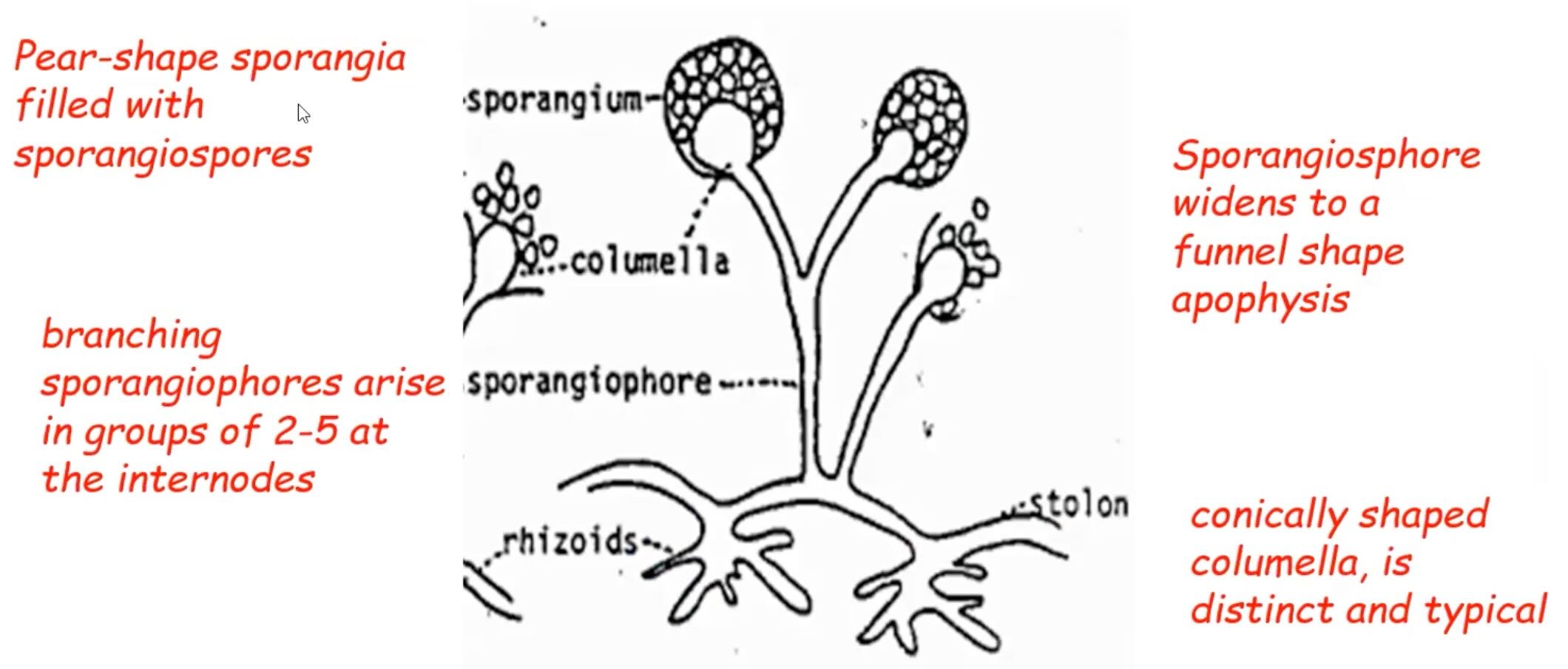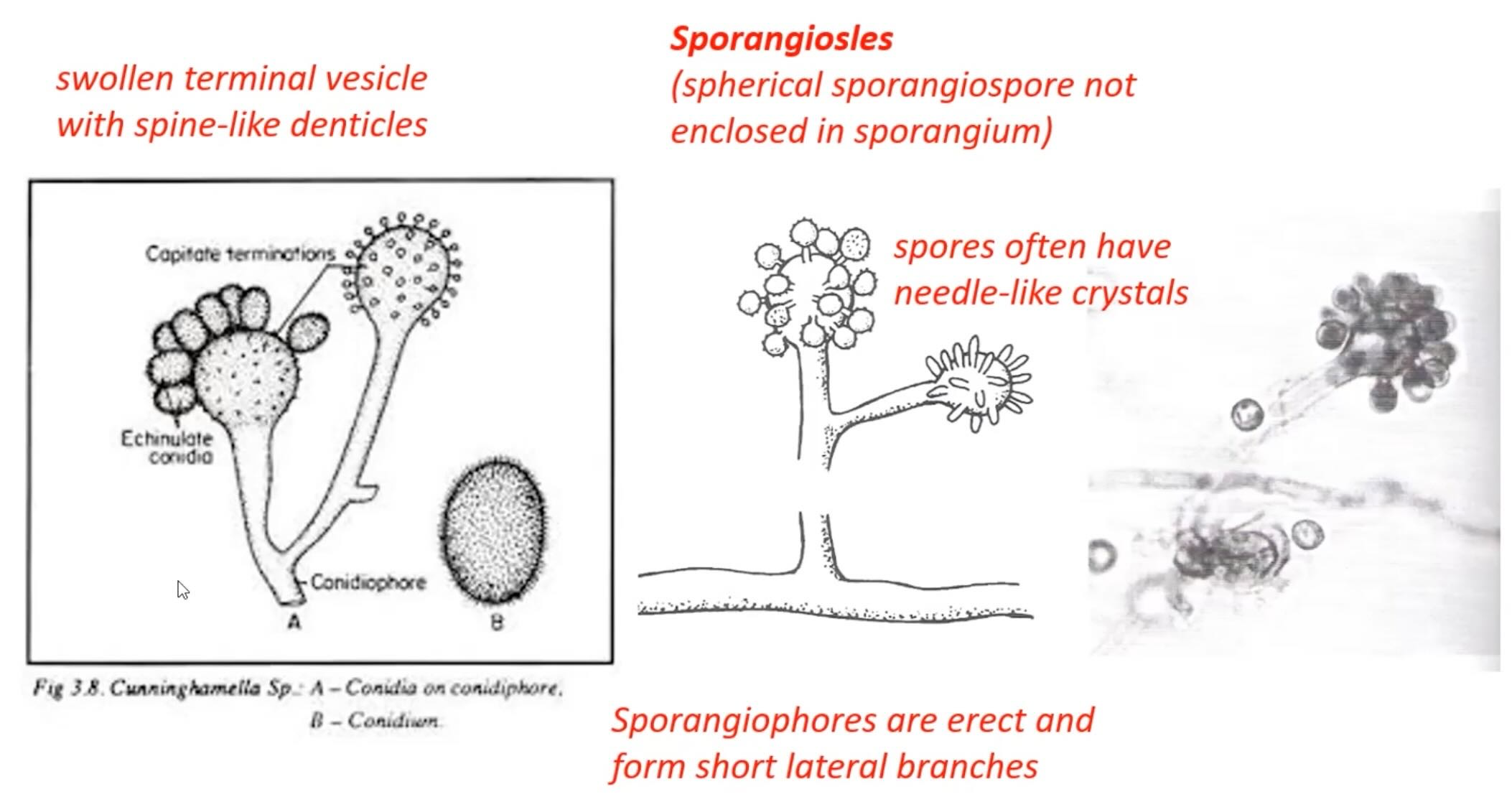Zygomycetes
0.0(0)
0.0(0)
New
Card Sorting
1/15
Earn XP
Description and Tags
Study Analytics
Name | Mastery | Learn | Test | Matching | Spaced |
|---|
No study sessions yet.
16 Terms
1
New cards
Zygomycetes
Fast growing fungi, present in the environment (saprophytic). Mostly ASEPTATE (coenocytic) hyphae (many nuclei/cells), SEXUAL reproduction through ZYGOSPORES, uncommon isolate in labs...presence means contamination or devastating zygomycosis in immunocompromised
2
New cards
Mucormycosis/Zygomycosis
Rare, severe, and fatal opportunistic infection that affects immunocompromised, broad spec antibiotics, breakdown of cutaneous barrier, burns, etc.
3
New cards
Mucormycosis/zygomycosis: infection process
1. Inhaled spores trapped in sinuses or reach distal airspace
2. Replication of spores occurs (usually macrophages and white blood cells would block replication... neutropenia, corticosteroid, etc. cannot)
3. Undetected fungal proliferation, angioinvasion (invasion of blood vessels), and necrosis
4. Progressing fungal invasion, hemorrhage, and necrosis
5. Extensive necrosis limits drug delivery and immune response
6. Dissemination
2. Replication of spores occurs (usually macrophages and white blood cells would block replication... neutropenia, corticosteroid, etc. cannot)
3. Undetected fungal proliferation, angioinvasion (invasion of blood vessels), and necrosis
4. Progressing fungal invasion, hemorrhage, and necrosis
5. Extensive necrosis limits drug delivery and immune response
6. Dissemination
4
New cards
Types of Mucormycosis/Zygomycosis
Rhinocerebral: Starts in sinus and spreads to brain, most common in uncontrolled diabetes
Pulmonary: inhalation of fungal spores
GI: Ingestion of the fungal spores; more common in infants
Pulmonary: inhalation of fungal spores
GI: Ingestion of the fungal spores; more common in infants
5
New cards
Mucormycosis/Zygomycosis: Specimen processing
Skin scrapings, sputum, and exudates examined by KOH preparation
6
New cards
Mucormycosis/Zygomycosis Microscopic Features
Aseptate broad ribbon-like hyphae with right-angle branching of conidiophores
7
New cards
Fungal Structures of Mucormycosis/Zygomycosis
*Appearance in culture, not specimens in tissue*
Columnella: sterile, dome-like structure at tip of sporangiophore
Apophysis: funnel-shaped swelling of sporangiophore, immediately below columnella (unique to and only seen in SOME zygomycetes)
Sporangiophore: specialized hyphae that bears a sporangium
Sporangium: sac-like structure producing asexual spores endogenously by cytoplasmic cleavage
Stolon: a running hyphae from which rhizoids and sporangiophores arise
Columnella: sterile, dome-like structure at tip of sporangiophore
Apophysis: funnel-shaped swelling of sporangiophore, immediately below columnella (unique to and only seen in SOME zygomycetes)
Sporangiophore: specialized hyphae that bears a sporangium
Sporangium: sac-like structure producing asexual spores endogenously by cytoplasmic cleavage
Stolon: a running hyphae from which rhizoids and sporangiophores arise
8
New cards
Rhizopus: Basic Info
Grows best at 45 degrees, sexual reproduction through zygospores , asexual reproduction through sporangium
9
New cards
Rhizopus: microscopic
Large , irregular aseptate hyphae (in vivo only you will see right angle branching hyphae)
Rhizoids (root-like hyphae)
Spherical sporangium
Columnella is spherical to elongated
Brown and unbranched sporangiophores
Non-prominent apophysis
Zygospores
Rhizoids (root-like hyphae)
Spherical sporangium
Columnella is spherical to elongated
Brown and unbranched sporangiophores
Non-prominent apophysis
Zygospores

10
New cards
Mucor: Basic Info
Found in soil, decaying fruits and vegetables
Infections found in humans, amphibians, cattle, and swine
Most grow at less than 37 degree C, but some are infectious to humans and are thermo-tolerant
Infections found in humans, amphibians, cattle, and swine
Most grow at less than 37 degree C, but some are infectious to humans and are thermo-tolerant
11
New cards
Mucor: Microscopic
Broad, aseptate/barely hyphae
No rhizoid hyphae
No apophysis or stolon
Round sporangium with round-oval sporangiospores
Sporangiophore are hyaline and can be branched or unbranched
Zygospores
No rhizoid hyphae
No apophysis or stolon
Round sporangium with round-oval sporangiospores
Sporangiophore are hyaline and can be branched or unbranched
Zygospores

12
New cards
Rhizomucor: Microscopic
*Has similar characteristics to rhizopus and mucor*
Aseptate or sparsely septate, broad hyphae
Rudimentary rhizoids located on stolons between sporangiophores
Brown and round Sporangium
No apophysis
Stolon present
Columnella are prominent and spherical to pyriform in shape
Sporangiospores are small and round to ellipsoidal
Irregularly branched sporangiophores
Zygospores, if present, round to slightly compressed and dark brown to blackish brown
Aseptate or sparsely septate, broad hyphae
Rudimentary rhizoids located on stolons between sporangiophores
Brown and round Sporangium
No apophysis
Stolon present
Columnella are prominent and spherical to pyriform in shape
Sporangiospores are small and round to ellipsoidal
Irregularly branched sporangiophores
Zygospores, if present, round to slightly compressed and dark brown to blackish brown

13
New cards
Absidia/Lichtheimia: Microscopic
Pyriform sporangium
Rhizoid hyphae between sporangiophores
Contain septa just below sporangium in the sporangiophore
Branching sporangiophores arise in groups of 2-5 at internodes
Sporangiophore widens at funnel-shaped apophysis
Conically-shaped columnella
Rhizoid hyphae between sporangiophores
Contain septa just below sporangium in the sporangiophore
Branching sporangiophores arise in groups of 2-5 at internodes
Sporangiophore widens at funnel-shaped apophysis
Conically-shaped columnella

14
New cards
Cunninghamella: Characeristics
Found in soil and plant material, especially in Mediterranean and subtropical zones (not in temperature climates)
In addition to being OPPORTUNISTIC, it is a common lab contaminant
In addition to being OPPORTUNISTIC, it is a common lab contaminant
15
New cards
Cunninghamella: Microscopic
Does not contain a sporangium, but rather terminal vesicles with SPORANGIOSLES that contain spherical sporangiospores
Sporangiosles often have needle-like projections
Sporangiophores erect and form short, lateral branches
Swollen terminal vesicle instead of sporangium with spine-like denticles... these terminal vesicles contain the sporangiosles
Sporangiosles often have needle-like projections
Sporangiophores erect and form short, lateral branches
Swollen terminal vesicle instead of sporangium with spine-like denticles... these terminal vesicles contain the sporangiosles

16
New cards
Five Zygomycetes Microscopic Overview
Rhizopus: have rhizoids; sporangium are round and pigmented and base is located at rhizoids
Mucor: no rhizoids, not pigmented, sporangiophore can branch irregularly
Rhizomucor: less developed rhizoids, rhizoids are not at base of sporangiophores, sporangiophores can branch
Absidia: pear-shape/pyriform sporangium, septum just below sporangium, well developed apophysis, sporangiophores arise between rhizoids
Cunninghamella: hyaline hyphae, erect sporangiophores that form lateral branches, swollen terminal vesicles at end of sporangiophore that contain sporangiosles projections that contain sporangiospores
Mucor: no rhizoids, not pigmented, sporangiophore can branch irregularly
Rhizomucor: less developed rhizoids, rhizoids are not at base of sporangiophores, sporangiophores can branch
Absidia: pear-shape/pyriform sporangium, septum just below sporangium, well developed apophysis, sporangiophores arise between rhizoids
Cunninghamella: hyaline hyphae, erect sporangiophores that form lateral branches, swollen terminal vesicles at end of sporangiophore that contain sporangiosles projections that contain sporangiospores